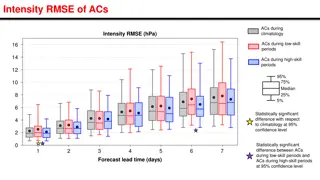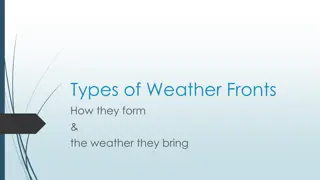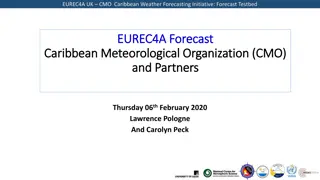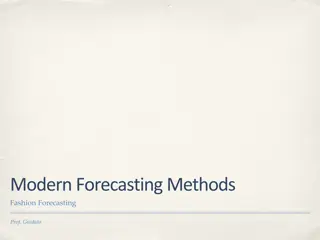Understanding Cloud Types and Their Significance in Weather Forecasting
Learn about different cloud types, their formation, characteristics, and implications for weather forecasting. From low-level stratocumulus to high-level cirrus, each type plays a unique role in indicating weather patterns. Explore the beauty and science behind nature's water carriers.
Download Presentation

Please find below an Image/Link to download the presentation.
The content on the website is provided AS IS for your information and personal use only. It may not be sold, licensed, or shared on other websites without obtaining consent from the author. Download presentation by click this link. If you encounter any issues during the download, it is possible that the publisher has removed the file from their server.
E N D
Presentation Transcript
Cloud Types Recognizing and appreciating Nature s water carriers
Convection: How Clouds Form Upward flowing air currents cause clouds to form Warm air condenses in higher cool air Warm air rises
Different Heights, Different Clouds Medium Level: Altocumulus High Level: Cirrocumulus Low Level: Stratocumulus
High Level: Cirrus Forms only in very dry air May mean fine weather will continue If cirrus increases to cover most of the sky, wind and rain may soon follow Cirrus is made up of falling ice crystals drawn out by the wind into filaments The longer the filaments, the stronger the wind Sailors once used cirrus clouds as a "wind warning"
High Level: Cirrocumulus A patch or layer of cloud consisting of tiny individual cloudlets at high level The cloudlets may make a regular dappled or rippled pattern Referred to as a "mackerel" sky May mean unsettled weather is on its way Like all high-level clouds, cirrocumulus is made of ice crystals
Cirrostratus May cover the sky as a continuous sheet with no features, but it often has a fibrous look Cloud is so thin it is almost transparent You can see the sun or moon through it Forms a halo around sun or moon Cirrostratus often signals changing weather
Medium Level: Nimbostratus Blanket of grey cloud hiding the sun and any higher cloud Sheet cloud from which rain or snow is falling Forms when warm, moist air is lifted steadily over a large area Thick enough to block out the sun Base can be quite low: anywhere from 2,000-7,000 ft (600-2,000 m) Usually the air is stable and there is little turbulence in the cloud
Medium Level: Altostratus From the ground altostratus looks white or slightly blue and watery May form a continuous sheet, or look as though it is made from soft fibres Light, with the sun often visible through it Rain or snow may fall. Frequently, though not always, covers the whole sky Clouds of other types may be visible at its edges or beneath it
Medium Level: Altocumulus Small, white, puffy clouds that sometimes slowly drift across the sky Looks like dozens, of small, loose cotton balls Forms between 8,000-18,000 ft (2.5-5.5 km) Usually forms in a layer of moist air, where air currents undulate gently As a layer rises, water vapour condenses, forming the cloud
Low Level: Cumulus Puffy white clouds that drift across the sky on a bright summer day Small and scattered, they re a sign of fine weather Clouds form in columns of rising air above ground that is being heated strongly by the sun As it rises it cools, and the water vapour condenses onto particles of matter called condensation nuclei
Low Level: Stratus Forms in stable air, which has little or no turbulence If it forms in air lifting over hills or along a front, it may be followed by rain Can also form at night when moist air moves over land that is cooling Base height is normally in the lowest 2,000 ft (600 m) of the atmosphere
Low Level: Stratocumulus Grey, white, or a mixture of both, usually with some darker patches Can look threatening, but unless it s very thick usually only drizzle or light rain falls from it Formed when warm, moist air mixes with drier, cooler air and the mixture is moving beneath warmer, lighter air above Base is typically at 1,000- 7,000 ft (300-2,000 m)























